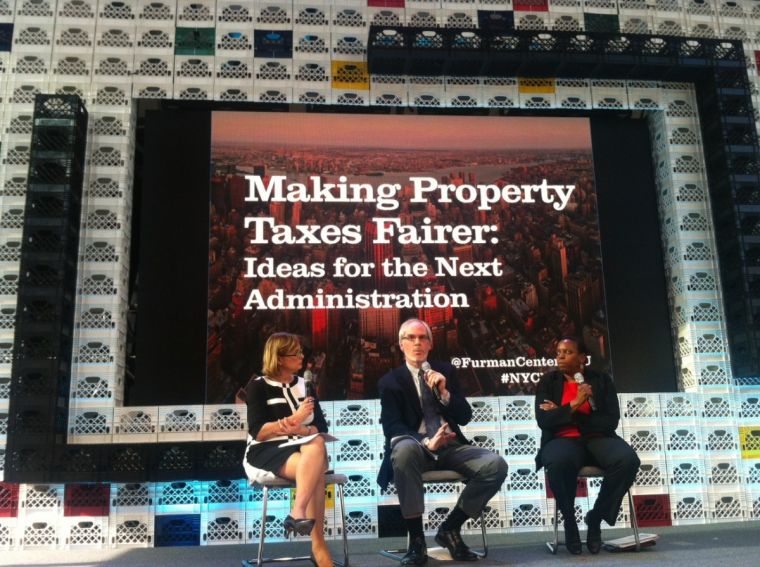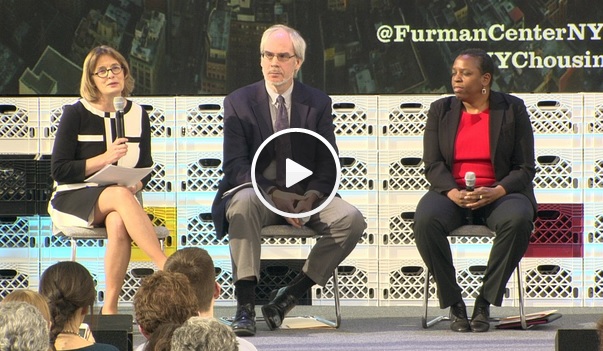
Furman Center’s Talking Transition Panel Outlines How to Make NYC Property Taxes Fairer

By design, NYC's property taxes favor homeowners over renters. As a result, New York City imposes one of the highest tax burdens on apartment buildings, and one of the lowest burdens on one- to three-family homes, of any large city in the country. Not only is this system unfair, but it may also discourage the development of rental buildings in a city desperately in need of more housing.
This was the focus of the discussion the Furman Center led at the Talking Transition event. The panel, titled Making Property Taxes Fairer: Ideas for the Next Administration, was moderated by Vicki Been, director of the NYU Furman Center, and included panelists George Sweeting, Deputy Director of the NYC Independent Budget Office, and Martha Stark, former Commissioner of the NYC Department of Finance.
 “New York City’s property tax system treats different kinds of properties differently for a wide range of policy reasons,” said Been. “The Furman Center’s Talking Transition panel allowed us to highlight these inequities, debate their advantages and disadvantages, and outline steps the next administration can take to make the property tax system fairer.”
“New York City’s property tax system treats different kinds of properties differently for a wide range of policy reasons,” said Been. “The Furman Center’s Talking Transition panel allowed us to highlight these inequities, debate their advantages and disadvantages, and outline steps the next administration can take to make the property tax system fairer.”
The panel discussion highlighted the key property tax rules that result in inequities across and within property types, which include:
- Disparities between Class 1 and Class 2. State law about what share of the property tax each class of property must pay dictates that Class 1 properties (1 to 4 unit houses) pay a lower share of the property tax than Class 2 properties (apartment buildings). However, Class 1 accounts for a much higher share of the total estimated market value in the city. This mismatch between value and tax burden results in Class 2 being taxed at a rate almost five times higher than Class 1.
- Disparities within Class 1. State law caps the amount that the assessed value (the portion of market value on which an owner pays taxes) can change. This results in large gaps between estimated market value and assessed value in areas that are appreciating quickly. Because of this cap, properties that have the same market values end up paying very different amounts in taxes.
- Disparities within Class 2. State law requires the city to use rental buildings as “comps” to value large condo and co-op buildings. For expensive co-op buildings, in particular, this results in dramatic undervaluation because, for these very valuable properties, comparable rental buildings simply do not exist. Because the amount of money that must be raised from Class 2 is fixed, the undervaluation of co-ops and condos means that the burden shifts to rental buildings in Class 2 to make up the difference.
Panelists then identified steps the new administration could take to deal with the disparities caused by the property tax system. These ideas included, among others:
- Improving the models for valuing Class 1 properties. The city could improve its models to ensure that they are correctly capturing market values in Class 1 across all types of neighborhoods. This can be done administratively by the Finance Commissioner.
- Allowing class shares to adjust yearly to the extent the law allows. State law sets the share of the property tax that each class of property must pay, and it also allows those shares to adjust up to 5 percent per year, to reflect changes in market value. However, the city regularly lobbies the state to lower that 5 percent cap. The share of the property tax that each property class pays would come closer to matching its share of estimated market value if the city stopped interfering with this yearly adjustment.
- Increasing awareness among renters. A number of the rules that result in inequitable treatment of properties cause rental buildings to bear a disproportionate share of the tax burden. While renters likely pay some amount of the property taxes levied against landlords, those costs are hidden, unlabeled, in their rent bill. The new mayor could require practices that increase renters’ awareness about the portion of rent bills that go towards property taxes.
- Lobbying the state for changes. Reforming the property tax system means changing state law. While the city can’t make fundamental changes to the system itself, it could lobby the state to pass reforms, including allowing the Department of Finance to value all property based on sales when appropriate; limiting departure from the yearly adjustments in property class shares, but tempering change in taxes by providing income-based property-tax relief; and, perhaps most importantly, moving towards a simplified and more transparent system.
The NYU Furman Center’s Talking Transition panel, Making Property Taxes Fairer: Ideas for the Next Administration took place on November 19th at 12:30pm. A video of the panel is now available.
For more on NYC’s property tax inequities, please see:
- Talking Transition events highlight web archive.
- NYU Furman Center policy brief: Shifting the Burden: Examining the Undertaxation of Some of the Most Valuable Properties in NYC (PDF)
- NYU Furman Center report: Distribution of the Burden of NYC’s Property Tax, from the State of NYC’s Housing & Neighborhoods 2011 (PDF)
- NYU Furman Center policy brief series: #NYC Housing: 10 Issues for NYC’s Next Mayor (PDF)
- NYC Independent Budget Office report: Twenty-Five Years After S7000A: How Property Tax Burdens Have Shifted in New York City (PDF)
Furman Center Policy Director, Jessica Yager, also participated at Talking Transition on a panel hosted by the Municipal Art Society of New York titled, Rethinking Regulation: New Priorities for City Building. She discussed the Furman Center's research on transferrable development rights, including regulatory barriers to using TDRs as a development tool in New York City.
For more on the Furman Center's TDR work, see our most recent policy brief, Buying Sky: The Market for Transferrable Development Rights in New York City (PDF).


